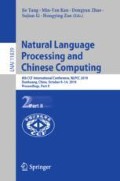Abstract
Smart service chatbot, aiming to provide efficient, reliable and natural customer service, has grown rapidly in recent years. The understanding of human-agent conversation, especially modeling the conversational behavior, is essential to enhance the machine intelligence during the customer-chatbot interaction. However, there is a gap between qualitative behavior description and the corresponding technical application. In this paper, we developed a novel fine-grained dialogue act framework specific to smartphone customer service to tackle this problem. First of all, following a data-driven process, we defined a two-level classification to capture the most common conversational behavior during smartphone customer service such as affirm, deny, gratitude etc., and verified it by tagging chatlog generated by human agent. Then, using this framework, we designed a series of technically feasible dialogue policies to output human-like response. As an example, we realized a smart service chatbot for a smartphone customer using the dialogue-act-based policy. Finally, a user study was conducted to verify its efficiency and naturalness. Since the dialogue acts are meaningful abstraction of conversational behavior, the dialogue-act-based chatbot could be more explainable and flexible than the end-to-end solution.
Q. Ding and G. Zhao—Both authors contributed equally to this research.
Access this chapter
Tax calculation will be finalised at checkout
Purchases are for personal use only
References
Jacobs, I., et al.: The top 10 Chatbots for enterprise customer service. Forrester Report (2017)
Xu, A., et al.: A new chatbot for customer service on social media. In: Proceedings of the 2017 CHI Conference on Human Factors in Computing Systems. ACM (2017)
Austin, J.L.: How To Do Things with Words. Oxford University Press, Oxford (1975)
Klüwer, T., Uszkoreit, H., Xu, F.: Using syntactic and semantic based relations for dialogue act recognition. In: Proceedings of the 23rd International Conference on Computational Linguistics: Posters. Association for Computational Linguistics (2010)
Zhao, T., Kawahara, T.: Joint dialog act segmentation and recognition in human conversations using attention to dialog context. Comput. Speech Lang. 57, 108–127 (2019)
Oraby, S., et al.: Modeling and computational characterization of Twitter customer service conversations. ACM Trans. Interact. Intell. Syst. (TiiS) 9(2–3), 18 (2019)
Jo, Y., et al.: Modeling dialogue acts with content word filtering and speak preferences. In: Proceedings of the Conference on Empirical Methods in Natural Language Processing. Conference on Empirical Methods in Natural Language Processing. NIH Public Access (2017)
Stolcke, A., et al.: Dialogue act modeling for automatic tagging and recognition of conversational speech. Comput. Linguist. 26(3), 339–373 (2000)
Kim, S.N., Cavedon, L., Baldwin, T.: Classifying dialogue acts in multi-party live chats. In: Proceedings of the 26th Pacific Asia Conference on Language, Information, and Computation (2012)
Bigelow, J.C.: Language, mind, and knowledge (minnesota studies in the philosophy of Science, Vol. VII). Linguist. Philos. 1(2), 301–304 (1977)
Core, M.G., Allen, J.: Coding dialogs with the DAMSL annotation scheme. In: AAAI Fall Symposium on Communicative Action in Humans and Machines, Boston, MA (1997)
Jurafsky, D., Shriberg, E., Biasca, D.: Switchboard-DAMSL labeling project coder’s manual. Technická Zpráva 97–02 (1997)
Ivanovic, E.: Using dialogue acts to suggest responses in support services via instant messaging. In: Proceedings of the Australasian Language Technology Workshop 2006 (2006)
Klüwer, T., et al.: Evaluation of the KomParse conversational non-player characters in a commercial virtual world. In: LREC (2012)
Author information
Authors and Affiliations
Corresponding author
Editor information
Editors and Affiliations
Rights and permissions
Copyright information
© 2019 Springer Nature Switzerland AG
About this paper
Cite this paper
Ding, Q. et al. (2019). Modeling Human Intelligence in Customer-Agent Conversation Using Fine-Grained Dialogue Acts. In: Tang, J., Kan, MY., Zhao, D., Li, S., Zan, H. (eds) Natural Language Processing and Chinese Computing. NLPCC 2019. Lecture Notes in Computer Science(), vol 11839. Springer, Cham. https://doi.org/10.1007/978-3-030-32236-6_54
Download citation
DOI: https://doi.org/10.1007/978-3-030-32236-6_54
Published:
Publisher Name: Springer, Cham
Print ISBN: 978-3-030-32235-9
Online ISBN: 978-3-030-32236-6
eBook Packages: Computer ScienceComputer Science (R0)


